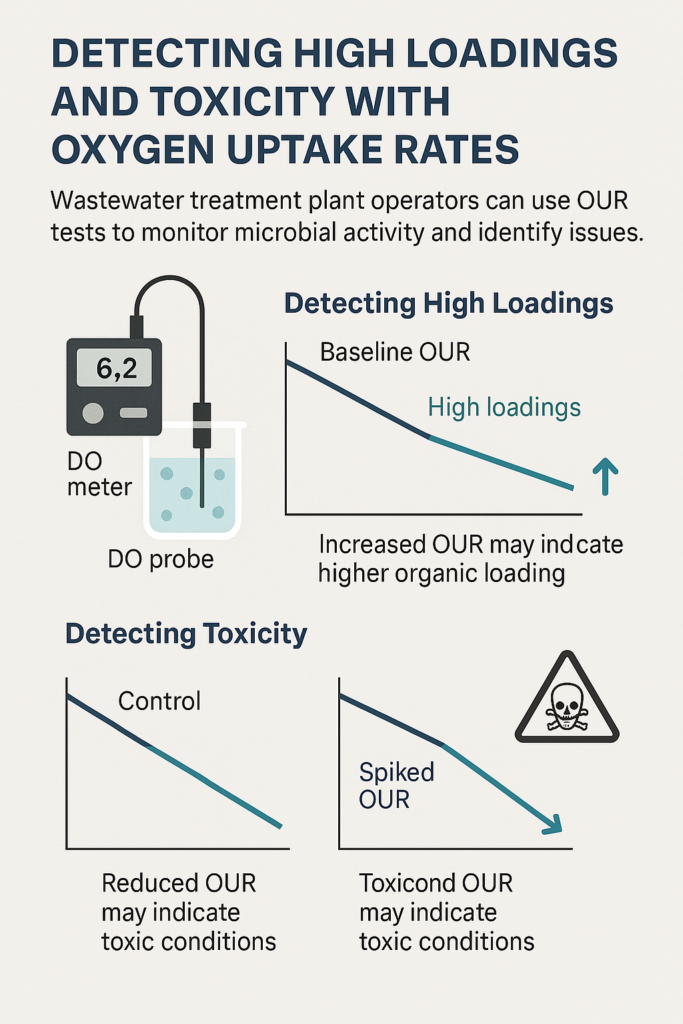
🧠 When biomass whispers, OUR listens. Oxygen Uptake Rate (OUR) is the microbial pulse check every operator should have in their back pocket. Measured with a simple dissolved oxygen (D.O.) meter in a BOD bottle, OUR reveals how actively the biological community is respiring—a direct reflection of system health, loading rates, and even toxicity. If you are unfamiliar with how to run an OUR, here is. our whitepaper on how to run the test using DO meter and a BOD bottle. https://asterbio.com/oxygen-uptake-rate-procedure/
📈 Why Measure OUR?
OUR offers near-instant insight into the metabolic activity of the microbes responsible for nutrient removal and organic degradation. Regular OUR monitoring helps operators:
- Track changes in influent organic loading
- Identify sudden toxicity events
- Fine-tune aeration and energy usage
- Validate the effectiveness of bioaugmentation strategies or nutrient balancing
It’s like getting a daily readout of microbial stress levels before anything becomes visible in the effluent—or worse, the permit.
🧪 Detecting High Loadings with OUR
When high organic loading hits the system, microbes ramp up their metabolism to deal with the feast—this manifests as a steep OUR slope. Here’s how to detect it:
- Baseline Test: Collect mixed liquor in a sealed container with a D.O. probe. Measure how fast the D.O. drops over time (mg/L/hr).
- Interpretation: A spike in OUR above normal benchmarks suggests increased biological activity—often caused by elevated BOD/COD.
- Operational Response: You might increase aeration, adjust return activated sludge (RAS) rates, or consider process staging if the spike is sustained.
Example: A dairy wastewater plant sees a sudden OUR jump from 20 to 45 mg/L/hr following a milk spill—time to increase aeration and notify the pretreatment operator.
☠️ Detecting Toxicity with Spiked OUR
OUR is also a frontline diagnostic tool for identifying microbial stress or inhibition caused by toxins. The spiked OUR test enhances sensitivity:
- Control Setup: Measure OUR using system sludge and standard substrate (e.g., glucose or peptone).
- Spiked Setup: Repeat the test after spiking with the influent or suspect stream.
- Compare:
- If OUR drops or flattens, it signals that something in the sample is acutely inhibiting microbial respiration.
- If OUR rises, there may be readily degradable compounds but no toxicity.
Example: In a tannery effluent stream, spiked OUR falls 30% below the control value—alerting the team to a potential inhibitory load of chromium or surfactants.
⚙️ Operational Integration
OUR testing can be integrated at key checkpoints:
- Daily monitoring at aeration basins
- Pre-screening batch loads from industrial contributors
- Post-bioaugmentation trials to confirm microbial recovery
- Following process upsets (e.g., pH swings, stormwater intrusion)
🚀 Conclusion
Think of OUR as your plant’s respiratory monitor—quietly warning you of stress before bulking, foaming, or permit violations hit. With spiked OUR techniques, you’re not just responding to problems—you’re predicting them.
Whether you’re running a high-rate SBR or a nutrient-sensitive MLE system, giving a voice to your microbes with an everyday D.O. meter could be your smartest move this year.

This is going to be incredibly useful for my work.